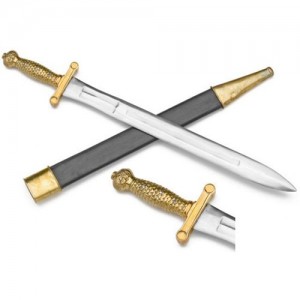So, you’ve seen all those daring swordfights and snazzy moves in the movies and now you are inspired to become a swordsman yourself. But be forewarned: using a sword is no walk in the park! It takes training and technique to be a smooth sword operator. Swordsmanship is one of the oldest and most varied forms of fighting and through the centuries, many forms and styles have developed. While it is no longer a practice in warfare, swordsmanship has remained an engaging artistry and form of self-defense.
In different cultures, different methods of swordsmanship derived. For example, in Rome, a gladiator used a shorter sword, known as a gladius, than the army swords. Both armies and gladiators trained first with wooden swords before advancing to the real thing, sharpened steel swords. In a similar fashion, German, Spanish, and Italian swordsmanship grew heavily during the medieval and renaissance periods. In China, swordsmanship was a vital part of martial arts and in Japan, many styles were developed, including the art of Kendo, which is still popular today. Over time, the art of swordsmanship has become known as fencing, and is even an Olympic sport in present day.
Bastard Sword:
In honing your skills as a swordsman, here are some helpful tips and techniques to consider. First, you should prepare for the fight by quickly drawing the sword from the scabbard. This may require a few tries before getting it right. When drawing the sword, it can tend to get stuck or tend to emerge slowly from the scabbard. The quicker the draw, the greater the edge on the opponent. In high intensity situations, such as a sword fight, the tendency is to get nervous and stressed. But take deep breaths and remain calm. This will allow you to think and act quickly on your feet and could very well be the difference between winning and losing. You should keep a balanced and relaxed posture, with distance between your feet. Don’t zone out! Pay careful attention to what your opponent is doing, as to avoid being caught off guard. When you parry, or block your opponent’s advance, the blade should stay close to the body for better protection. Stay focused: Remember the goal is to counter your opponent’s attacks. Just like a poker game, expertise alone doesn’t win a game; you have to know your player. Thus, take a brief moment to read your opponent and identify the strengths and weaknesses of their skills.
Artillery Short Sword:
When going in for the kill, make vigorous and confident moves, but don’t get carried away. Stay grounded, keeping your elbows close to the body and extending the sword toward the opponent. Stand perpendicular to your opponent, with the sword pointed directly at them. By holding this position, your chances of being wounded are decreased, as it ensures minimum access to the body. According to the length of the sword, measure the distance between your opponent in proportion. If you are using a longer sword, keep a greater distance from the opponent and if you are using a shorter sword, stay close to them. And over all these things, accuracy and agility are the most important elements of a sword fight. Strong and powerful weapons can be overcome by skillful maneuvers and techniques.
Sword fighting is indeed exciting and challenges the mind and body, but it starts with the basics. Once the groundwork is laid, there is a whole world to explore in swordsmanship. In fact, there are several classes that equip you to be a master fighter. And as always, practice makes perfect! To join the fun, select your sword of choice from our collection at: http://www.armorvenue.com/




